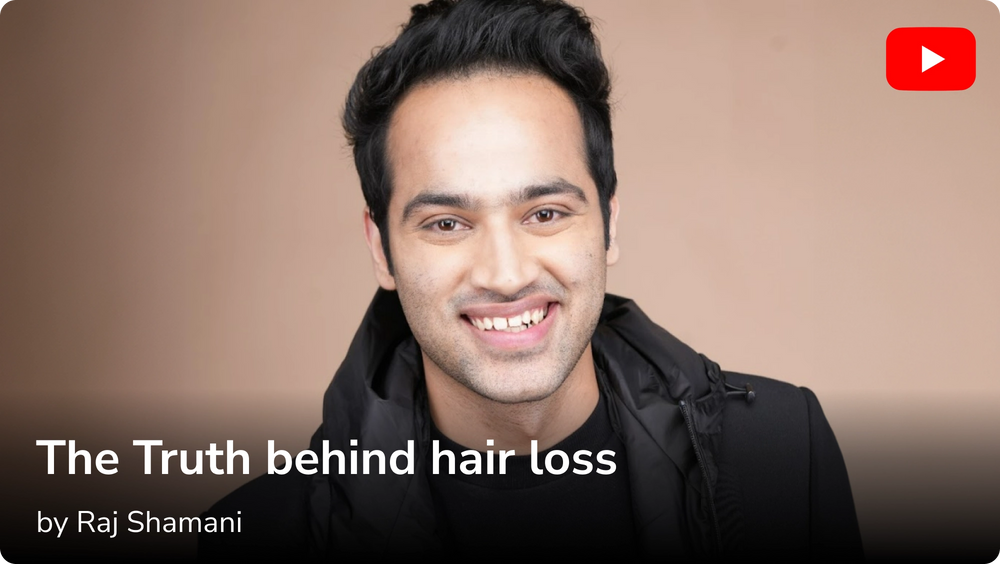"कम उम्र में बाल झड़ने का क्या कारण है", एक सामान्य प्रश्न है, जिससे हम सभी का सामना करना पड़ता है। लेकिन इसके बारे में अधिकांश लोगों को जागरूकता नहीं होती है, खासकर जब यह युवा उम्र में होता है। बालों का झड़ना एक प्राकृतिक प्रक्रिया है, जिसमें पुराने बाल नए बालों के लिए जगह बनाने के लिए छोड़ देते हैं। लेकिन कभी-कभी इस प्रक्रिया में असमय बदलाव हो सकता है और बाल बेहद कम उम्र में ही झड़ने लगते हैं।
कम उम्र में बाल झड़ने की समस्या का संख्यात्मक आंकड़ों के अनुसार बढ़ रहा है। एक अध्ययन के अनुसार, यह समस्या आजकल के युवाओं में अधिक हो रही है, और यह 21 और 30 के बीच की उम्र के लोगों में सबसे अधिक दिखाई देता है। कम उम्र में बाल झड़ने के कारण को जानना महत्वपूर्ण है, ताकि हम इस समस्या का समाधान ढूंढ सकें।
बाल झड़ना एक ऐसी समस्या है जिससे न केवल आपके बालों को कमजोरी महसूस होती है, बल्कि यह आपकी आत्मविश्वास को भी प्रभावित कर सकती है। कई बार इस समस्या के कारण और उपचारों के बारे में जानकारी होने से यह समस्या निपटाने में आसानी हो सकती है। इस ब्लॉग में हम बाल झड़ने के कुछ कारणों पर विचार करेंगे और संभवतः इस समस्या से निपटने के उपायों पर भी चर्चा करेंगे।
क्या आपके 20 के दशक में बाल झड़ते हैं?
बाल गिरते हुए कुछ ऐसा हुआ करता था जिसे हम उम्र बढ़ने से जुड़े थे। लेकिन इन दिनों, अधिक से अधिक लोग अपने शुरुआती 20 के दशक में, कभी -कभी उनकी देर से किशोर में भी अत्यधिक बाल बहाए जा रहे हैं। तो, क्या यह नया सामान्य है?
खैर, यह आम हो सकता है, लेकिन यह सामान्य नहीं है।
सिर्फ इसलिए कि कई युवा सोचते है की hair fall kaise roke aur वयस्कों को बालों के झड़ने का सामना करना पड़ रहा है, इसका मतलब यह नहीं है कि इसे अनदेखा किया जाना चाहिए। वास्तव में, शुरुआती उम्र के बालों का पतन अक्सर एक लाल झंडा होता है जो कुछ गहरा चल रहा है। इसके कारण हो सकता है:
तनाव और चिंता:
आधुनिक जीवन प्रदर्शन करने के लिए एक निरंतर दबाव के साथ आता है, चाहे वह शिक्षाविद, कैरियर या सोशल मीडिया हो। और उच्च तनाव का स्तर आपके बालों के विकास चक्र को बाधित कर सकता है।
पोषक तत्वों की कमी:
विटामिन डी, बी 12, लोहे या प्रोटीन जैसे प्रमुख पोषक तत्वों में कमी बालों की जड़ों को कमजोर कर सकती है और समय से पहले बालों के गिरने का कारण बन सकती है।
हार्मोनल असंतुलन:
पीसीओएस, थायरॉयड डिसफंक्शन, या डीएचटी संवेदनशीलता जैसी स्थितियां आपके 20 के दशक में भी बालों के झड़ने को ट्रिगर कर सकती हैं।
गरीब जीवन शैली की आदतें:
भोजन लंघन, नींद की कमी, क्रैश डाइटिंग, धूम्रपान, या गर्मी-स्टाइलिंग टूल का अति प्रयोग करना सभी आपकी खोपड़ी और रोम पर एक टोल लेते हैं।
जेनेटिक कारक:
यदि बालों के झड़ने का पारिवारिक इतिहास है, विशेष रूप से पुरुष या महिला पैटर्न गंजापन, तो संकेत जल्दी दिखा सकते हैं।
कम उम्र में बाल झड़ने के कारण
जीवनशैली संबंधित कारण (Lifestyle Related Reasons)
१) खानपान में असंतुलन (Unhealthy Food Habits)
कम उम्र में बाल झड़ने के कारण में से एक है खानपान में असंतुलन। अधिक तला हुआ, तली हुई या प्रोसेस्ड खाद्य पदार्थों का सेवन बालों के स्वास्थ्य को प्रभावित कर सकता है। इसके बजाय, हमें प्रोटीन, विटामिन, और मिनरल्स की सही मात्रा में लेना चाहिए, जो हमारे बालों के लिए आवश्यक है। अच्छा पोषण और सही विटामिनों की कमी कम उम्र में बाल झड़ने का मुख्य कारण हो सकता है। आपके शिशु को सही पोषण प्राप्त करने के लिए, उन्हें अच्छा खाना देना चाहिए, जैसे कि फल, सब्जियाँ, और प्रोटीन-रिच आहार। विटामिन और खनिज सप्लीमेंट्स का इस्तेमाल करने से पूरी की जा सकती है।
इसके अलावा, भोजन छोड़ देना या चरम आहार का पालन करना (जैसे क्रैश डाइट) शरीर को झटका दे सकता है और बालों को पतला कर सकता है। सही समय पर भोजन करना और ओमेगा -3 फैटी एसिड (जैसे अखरोट, फ्लैक्ससीड्स, या मछली) सहित भोजन भी मजबूत, स्वस्थ बालों का समर्थन करता है।
२) अधिकतम स्ट्रेस और मानसिक तनाव (Stress and Depression)
मानसिक तनाव और स्ट्रेस युवाओं के बालों के स्वास्थ्य पर गहरा प्रभाव डाल सकते हैं, और तनाव के युवाओं पर पड़ने वाले प्रभावों के बारे में एक अध्ययन भी इसे साबित कर रहा है। Traya द्वारा किये गए एक अध्ययन के अनुसार, 25 वर्ष से कम आयु के 60% युवाओं को तनाव के कारण बालों का झड़ना हो रहा है।
युवाओं के लिए अधिकतम स्ट्रेस और तनाव का आदिक नेगेटिव प्रभाव हो सकता है। इसके कारण मानसिक स्वास्थ्य पर दुश्मनीकारक प्रभाव होता है, जिससे उन्हें उदासी, चिंता, और नींद की कमी का सामना करना पड़ सकता है। तनाव, युवाओं का शारीरिक स्वास्थ्य भी प्रभावित हो सकता है। यह स्थितियां उनके रक्तचाप, डायबिटीज, और अन्य स्वास्थ्य समस्याओं के बढ़ने के खतरे को बढ़ा सकती हैं, जिससे कम उम्र में बाल झड़ने के कारण बालों के स्वास्थ्य को प्रभावित किया जा सकता है। तनाव के चलते हार का स्तर बढ़ सकता है, और यह बालों के प्रति रक्तसंचार को कम करके उनके पोषण को प्रभावित कर सकता है। इसके परिणामस्वरूप बाल झड़ सकते हैं।
तनाव आपके हार्मोन को बाधित करता है, जो बालों के प्राकृतिक विकास चक्र को बाधित कर सकता है। क्रोनिक स्ट्रेस अक्सर टेलोजेन या "फॉल-आउट" चरण में बालों को धक्का देता है, जिसे टेलोजेन इफ्लुवियम के रूप में जाना जाता है। उसके शीर्ष पर, तनाव से नींद की कमी, अस्वास्थ्यकर खाने और शारीरिक गतिविधि की कमी जैसी खराब जीवन शैली की आदतें हो सकती हैं, जिनमें से सभी बालों की जड़ों को कमजोर करते हैं और बालों के झड़ने में योगदान करते हैं।
३) धूम्रपान और मादक पदार्थों का सेवन (Smoking and Consumption of harmful substances)
धूम्रपान और मादक पदार्थों का सेवन भी बालों के स्वास्थ्य को बिगाड सकता है। निकोटीन और अन्य जहरीले तत्व बालों के प्रति मांगी जाने वाली पोषण को कम कर सकते हैं और इससे बालों का झड़ना बढ़ सकता है। धूम्रपान में मौजूद निकोटीन बालों के झड़ने को बढ़ा सकता है। निकोटीन रक्तसंचार को प्रभावित करता है और यह बालों के पौष्टिक तत्वों की पहुंच को कम कर सकता है, जिसके परिणामस्वरूप बाल झड़ सकते हैं। धूम्रपान आत्मा को तनावपूर्ण बना सकता है, और यह तनाव भी बालों के झड़ने का कारण बन सकता है। तनाव बालों के प्रति रक्तसंचार को कम करता है और उनके पोषण को प्रभावित कर सकता है।
धूम्रपान छोड़ने का प्रयास करते समय, एक चिकित्सक से सलाह लेना बेहद महत्वपूर्ण है। वे आपको संशोधन चिकित्सा के तरीकों का मार्गदर्शन कर सकते हैं, जैसे कि निकोटीन विकसायित्रक या आदिक दवाओं का उपयोग करके।
धूम्रपान सिर्फ आपके फेफड़ों को प्रभावित नहीं करता है, यह सीधे आपके बालों को भी प्रभावित करता है। अध्ययनों से पता चला है कि नियमित धूम्रपान स्वस्थ कोशिकाओं पर हमला करने वाले मुक्त कणों को उत्पन्न करके बालों के रोम को नुकसान पहुंचा सकता है। यह DHT (बालों के झड़ने से जुड़ा एक हार्मोन) का उत्पादन भी बढ़ाता है। इसके अलावा, अल्कोहल और ड्रग्स जैसे पदार्थ निर्जलीकरण और पोषण संबंधी कमियों का कारण बन सकते हैं, जिससे बाल सूखे, भंगुर और अधिक गिरने की संभावना हो सकती है।
शारीरिक कारण (Health Reasons)
४) आनुवंशिक कारण (Genetic Hair fall)
बालों के झड़ने के पीछे आनुवंशिक (जेनेटिक) कारण भी हो सकते हैं। यदि आपके परिवार में बालों के झड़ने की समस्या है, तो यह आपके लिए भी समस्या बन सकती है। यदि आपके परिवार में बालों के झड़ने की समस्या पाई जाती है, तो आपके लिए भी इससे गुजरने की संभावना होती है, क्योंकि यह आपकी आनुवंशिक धारणा से संबंधित हो सकता है। आपके माता-पिता और पूर्वजों की आनुवंशिक धारणाएं आपके बालों के स्वास्थ्य को प्रभावित कर सकती हैं। यदि उनमें से किसी को बालों के झड़ने की समस्या थी, तो आपकी भी वही समस्या हो सकती है। जेनेटिक प्राकृतिकता आपके बालों के स्वास्थ्य को प्रभावित कर सकती है, लेकिन यह निश्चित नहीं करती कि आप बालों के झड़ने का अवश्य होंगे।
अगर आपका आहार पूरी तरह से संतुलित नहीं है और आपके शरीर को आवश्यक पोषण नहीं मिल रहा है, तो आपके बालों के स्वास्थ्य को प्रभावित हो सकता है। हार मिनेजमेंट द्वारा किसी भी यौनक्रिया से जुड़े बालों को असर कर सकता है, और यह उनके झड़ने को बढ़ा सकता है।
आनुवंशिक बालों का झड़ना, जिसे एण्ड्रोजेनिक एलोपेसिया के रूप में भी जाना जाता है, पुरुषों और महिलाओं दोनों में बालों के पतले होने के लिए सबसे आम कारणों में से एक है। पुरुषों में, यह आमतौर पर एक पुनरावर्ती हेयरलाइन या मुकुट पर पतला होने के साथ शुरू होता है, जबकि महिलाएं अक्सर एक चौड़ी भाग या समग्र पतले होने की सूचना देती हैं।
इसलिए, यह महत्वपूर्ण है कि आप अपने बालों की देखभाल को शुरू करें और स्वस्थ जीवनशैली के साथ उन्हें पूरी तरह से संरक्षित रखें, खासकर यदि आपके परिवार में बालों के झड़ने की समस्या रही है।
यह भी पढ़ें: Hair Fall Solution in Hindi - Hair Fall Kaise Roke
५) हार्मोनिक असंतुलन - तत्वाधान में मासिक धर्म और थायरॉइड (Hormonal Reasons- Thyroid and other imbalances)
युवकों में बालों के झड़ने का मुख्य कारण परिपुरुष हार्मोन (टेस्टोस्टेरोन) के स्तर में परिवर्तन हो सकता है। यह हार्मोन बालों के झड़ने के कारण बदलाव को उत्पन्न कर सकता है, जिससे युवकों में अच्छे बालों के संरक्षण की कठिनाइयां हो सकती हैं।
थायरॉइड ग्रंथियों की सही कार्य प्रणाली के लिए महत्वपूर्ण हैं, और इनके असंतुलन के कारण भी बालों के झड़ने की समस्या उत्पन्न हो सकती है। थायरॉइड समस्याओं में ज्यादा थायरॉक्सीन (थायरॉइड हार्मोन) या थायरॉइड स्तर कम होने की स्थितियां हो सकती हैं, दोनों ही बालों के स्वास्थ्य को प्रभावित कर सकती हैं।
थायरॉयड के मुद्दों के अलावा, महिलाओं में पीसीओएस जैसी अन्य हार्मोनल स्थितियां भी बालों के पतले या बालों को गिर सकती हैं, खासकर कम उम्र में। पुरुषों में, DHT के उच्च स्तर (टेस्टोस्टेरोन का एक उपोत्पाद) बालों के रोम को कम कर सकता है और बालों के शुरुआती झड़ने का कारण बन सकता है। हार्मोनल असंतुलन अचानक वजन परिवर्तन, तनाव, या जन्म नियंत्रण की गोलियों या स्टेरॉयड जैसी कुछ दवाओं का उपयोग करने के कारण भी हो सकता है। अपने हार्मोन के स्तर की जाँच करना महत्वपूर्ण है यदि बालों का पतन अचानक, गंभीर, या अन्य लक्षणों जैसे वजन बढ़ने, थकान या अनियमित अवधि के साथ होता है।
यह हार्मोन्स के असंतुलन के कारण युवाओं में बालों के झड़ने की समस्या उत्पन्न हो सकती है, और इसके परिणामस्वरूप, सही खानपान और समय पर चिकित्सा उपाय से इस समस्या का सामना करना महत्वपूर्ण हो सकता है। युवाओं को अपने डॉक्टर से नियमित रूप से जांच करवाना और हार्मोनल संतुलन को बनाए रखने के लिए उपयुक्त उपायों का पालन करना चाहिए।
६) चर्म रोग और अन्य रोग (Skin diseases and other disorders)
कुछ त्वचा की स्थिति और अंतर्निहित स्वास्थ्य के मुद्दे भी युवा व्यक्तियों में बालों के गिरने का कारण बन सकते हैं। खोपड़ी सोरायसिस या फंगल संक्रमण जैसी बीमारियां खोपड़ी पर सूजन, फ्लेकिंग या लालिमा का कारण बनती हैं, जो बालों के रोम को उचित पोषण प्राप्त करने से रोक सकती है। यह अक्सर बढ़े हुए बाल शेडिंग में परिणाम होता है।
कभी-कभी, इन त्वचा की समस्याओं का इलाज करने के लिए उपयोग की जाने वाली दवाएं, जैसे कि स्टेरॉयड क्रीम या मजबूत विरोधी भड़काऊ दवाएं स्वयं स्वस्थ बालों के विकास में हस्तक्षेप कर सकती हैं। इसके अलावा, पोषण संबंधी कमी (विशेष रूप से विटामिन डी और ओमेगा -3 फैटी एसिड) इन स्थितियों के दौरान बालों को खराब कर सकते हैं।
त्वचा के मुद्दे और बालों के झड़ने को प्रभावी ढंग से प्रबंधित करने के लिए उचित निदान, समय पर उपचार और एक संतुलित आहार आवश्यक है।
कई चर्म रोग और अन्य शारीरिक रोग भी बालों के झड़ने का कारण बन सकते हैं। इन रोगों के इलाज के बाद, बालों का झड़ना रुक सकता है। हेयर फॉल या बालों का झड़ना किसी भी उम्र में असामान्य हो सकता है, और युवाओं में चर्म रोग (प्लेक प्सोरायसिस) जैसे चर्म रोगों का एक महत्वपूर्ण कारण हो सकता है। यह त्वचा संबंधित रोग होते हैं, जिनमें त्वचा के परिपथों में सूजन और लाल दाने होते हैं, और ये युवाओं में भी प्रभावित कर सकते हैं।
चर्म रोग के कारण स्केल्प पर भी सूजन हो सकती है, जिससे बालों के रूप और स्वस्थ बनाने के लिए जरूरी पोषण की पहुंच में बाधा हो सकती है। यदि स्केल्प के क्षेत्र में इस प्रकार की समस्या हो, तो यह बालों के झड़ने को बढ़ा सकती है।
चर्म रोग का इलाज आमतौर पर कॉर्टिकोस्टेरॉयड क्रीम्स और अन्य दवाओं के साथ होता है, जो त्वचा पर प्रभाव डालते हैं। ये दवाएँ बालों के स्वस्थ विकास को प्रभावित कर सकती हैं, और इसके परिणामस्वरूप बालों के झड़ने की गति में बढ़ोतरी हो सकती है।
युवाओं में चर्म रोग के इलाज के दौरान, विटामिन डी और ऑमेगा-3 फैटी एसिड्स की कमी हो सकती है, जो बालों के स्वास्थ्य के लिए महत्वपूर्ण हैं। यह नुकसान बालों के झड़ने की समस्या को बढ़ा सकता है।
चर्म रोग युवाओं में हेयर फॉल का कारण बन सकता है, क्योंकि यह त्वचा और स्केल्प के स्वास्थ्य को प्रभावित करता है और इसके परिणामस्वरूप बालों के झड़ने की गति को बढ़ा सकता है। इसके इलाज के दौरान सही पोषण और त्वचा की देखभाल करना महत्वपूर्ण है, ताकि बालों को झड़ने से बचाया जा सके।
चिकित्सा संबंधित कारण (Other Medical Reasons)
७) दवाओं के दुष्प्रभाव (Side Effects of Medication)
कुछ दवाएं और चिकित्सा उपचार बालों के गिरने को ट्रिगर कर सकते हैं, खासकर जब उच्च खुराक में या लंबे समय तक लिया जाता है। एंटीडिप्रेसेंट्स, बीटा-ब्लॉकर्स, एंटीकोआगुलंट्स, डॉक्सीसाइक्लिन और कुछ हार्मोनल उपचारों जैसे ड्रग्स को प्राकृतिक बालों के विकास चक्र के साथ हस्तक्षेप करने के लिए जाना जाता है, जिससे पतले या टूटना होता है। बच्चों में, बीमारी के दौरान अत्यधिक दवा भी बालों की जड़ों को कमजोर कर सकती है, जिससे उन्हें बहाने के लिए अधिक प्रवण हो सकता है।
ये दुष्प्रभाव तुरंत ध्यान देने योग्य नहीं हो सकते हैं, लेकिन धीरे -धीरे बालों की ताकत और बनावट को प्रभावित कर सकते हैं। यदि आप एक नई दवा शुरू करने के बाद असामान्य बाल गिरते हैं, तो अपने डॉक्टर से परामर्श करना महत्वपूर्ण है। समय पर चर्चा और खुराक या विकल्प में संभावित परिवर्तन दीर्घकालिक बालों के नुकसान को रोकने में मदद कर सकते हैं।
कुछ दवाएं और चिकित्सा प्रक्रियाएँ भी बालों के झड़ने का कारण बन सकती हैं। बच्चों को ठीक होने के लिए कई बार अधिक मात्रा में दवाएं दी जाती हैं, जो उनके बालों को कमजोर और झड़ने के प्रति संवेदनशील बना सकती हैं। इससे बचने के लिए, आपको बच्चे के डॉक्टर से सलाह लेनी चाहिए और दवाओं का सही समय पर सेवन करने का सुनिश्चित करना चाहिए।
बालों के झड़ने का कारण बनने वाला एक महत्वपूर्ण कारक दवाओं के दुष्प्रभाव हो सकता है। यह दुष्प्रभाव बालों के स्वास्थ्य को प्रभावित करके उनके झड़ने को बढ़ा सकते हैं।
कई प्रकार की दवाएं, खासकर जब वे उच्च मात्रा में और लंबे समय तक ली जाती हैं, बालों को प्रभावित कर सकती हैं। यह दवाएं अल्परासिनोल, डॉक्सीसाइक्लिन, बेटा-ब्लॉकर्स, एंटीकोग्यूलेंट्स, और एंटीडिप्रेसेंट्स जैसी रोज़ाना के दवाओं में पाई जा सकती हैं।
दवाओं के सेवन के परिणामस्वरूप, बालों के मूलों की कमजोरी हो सकती है और वे टूटने लगते हैं। इससे बालों की गुणवत्ता कम हो सकती है और झड़ने का खतरा बढ़ सकता है। अगर कोई व्यक्ति लम्बे समय तक और अत्यधिक मात्रा में किसी दवा का सेवन करता है, तो इससे उनके बालों की गुणवत्ता प्रभावित हो सकती है और वे कमजोर हो सकते हैं।
इसलिए, व्यक्तिगत स्वास्थ्य समस्याओं के इलाज के दौरान, यह महत्वपूर्ण है कि व्यक्ति अपने डॉक्टर से दवाओं के सेवन के संबंध में चर्चा करें और कोई दुष्प्रभाव होने पर उन्हें सूचित करें, ताकि समय रहते पर साइड-इफेक्ट्स का सामना किया जा सके।
यह भी पढ़ें: बाल टूटना कैसे रोके
८) चिकित्सा प्रक्रिया जैसे की कीमोथेरेपी (Medical Procedures like Surgery or Chemotherapy)
कैंसर जैसी गंभीर बीमारियों के इलाज के लिए कीमोथेरेपी एक महत्वपूर्ण और प्रभावी उपाय हो सकता है। इस प्रक्रिया में विशेष प्रकार की दवाओं का प्रयोग किया जाता है, जो कैंसर को खत्म करने और रोकने के लिए डिज़ाइन किए जाते हैं, लेकिन इसके साथ ही एक प्रमुख साइड-इफेक्ट है, जिसे बालों के झड़ना का खतरा होता है।
कीमोथेरेपी जैसे उपचार, हालांकि जीवन-रक्षक, बालों के झड़ने सहित दुष्प्रभाव हो सकते हैं। कीमोथेरेपी दवाओं को कैंसर कोशिकाओं को तेजी से विभाजित करने और नष्ट करने के लिए डिज़ाइन किया गया है। हालांकि, चूंकि बाल कूप कोशिकाएं भी जल्दी से विभाजित होती हैं, ये दवाएं अक्सर उन्हें भी प्रभावित करती हैं, जिससे अस्थायी बाल गिरते हैं या बालों के झड़ने को पूरा किया जाता है।
कीमोथेरेपी से बाल गिरते हैं आमतौर पर उपचार के कुछ हफ्तों के भीतर शुरू होता है और इसमें खोपड़ी, भौहें, पलकें और शरीर के बाल शामिल हो सकते हैं। हालांकि यह भावनात्मक रूप से चुनौतीपूर्ण हो सकता है, लेकिन उपचार आमतौर पर उपचार समाप्त होने के कुछ महीनों बाद फिर से शुरू होता है।
कीमोथेरेपी से गुजरने वाले रोगियों के लिए यह आवश्यक है कि वे अपने डॉक्टर के साथ बात करें कि क्या उम्मीद की जाए और बालों के झड़ने का प्रबंधन कैसे किया जाए, चाहे वह विग्स, हेड कवर, या स्कैल्प-कूलिंग उपचारों के माध्यम से हो जो बालों के झड़ने को कम करने में मदद कर सकते हैं।
कीमोथेरेपी के दुष्प्रभावों के बावजूद, इसका उपयोग कैंसर के इलाज में महत्वपूर्ण होता है, और यह रोगियों के लिए जीवन को बचाने में मदद कर सकता है।
पारिस्थितिकी और वातावरणिक कारण (Environmental Reasons)
९) प्रदूषण (Pollution)
प्रदूषण एक महत्वपूर्ण और गंभीर समस्या है जो आजकल हमारे आस-पास बढ़ गई है। यह न केवल हमारे पार्यावरण के लिए हानिकारक है, बल्कि हमारे स्वास्थ्य के लिए भी खतरा पैदा कर सकता है, और इसका बालों के स्वास्थ्य पर भी असर पड़ सकता है।
अधिकांश शहरों में वायु प्रदूषण एक समस्या बन चुकी है, और यह बालों के स्वास्थ्य को प्रभावित कर सकता है। वायु में मौजूद विषाणु, धूल, और वायुमंडलीय गैसेस बालों के मूलों को कमजोर और ब्रिटल बना सकते हैं, जिससे उनका झड़ना तेज हो सकता है। प्रदूषण भरे पानी का उपयोग करना भी बालों के लिए हानिकारक हो सकता है। रेडियेशन और अन्य अंतरिक्ष से आने वाले तत्व बालों के मूलों को कमजोर करके उनका झड़ना बढ़ा सकते हैं।
सबसे महत्वपूर्ण बात है कि हम प्रदूषण को कम करने के उपायों को अपनाएं, जैसे कि पेड़ों की वृक्षारोपण, पानी के सही तरीके से प्रबंधन, और वायु प्रदूषण कम करने के उपाय।
हमें अपने बालों की देखभाल को भी महत्वपूर्ण रूप से ध्यान में रखना चाहिए, जैसे कि उन्हें नियमित रूप से धोना, सही तरीके से खाना, और सही तरीके से मालिश करना।
१०) अधिकतम UV किरनों का प्रभाव (UV Rays and Sunlight)
अधिकतम UV (Ultraviolet) किरनें हमारे बालों के स्वास्थ्य पर नकारात्मक प्रभाव डाल सकती हैं। यह किरनें सूरज से आती हैं और उनका प्रमुख स्रोत हैं। निम्नलिखित हैं कुछ तरीके जिनमें अधिकतम UV किरनों का प्रभाव होता है:
अधिक UV किरनें बालों के मूलों को कमजोर बना सकती हैं, जिसके परिणामस्वरूप वे ब्रिटल और प्रवृद्ध हो सकते हैं। इसका अर्थ है कि उनका झड़ना और टूटना आसानी से हो सकता है।
UV किरनें बालों की प्राकृतिक तरीके से आपातकालीन निष्कासन को बढ़ा सकती हैं, जिससे बालों का सूखापन बढ़ सकता है। यह बालों को अधिक कुश्तग्रस्त बनाता है और उनका झड़ना तेज हो सकता है। UV किरनें बालों के रंग को बदल सकती हैं, खासकर जब वे अधिक समय तक सूरज के तहत रहते हैं। इससे बालों का रंग फीका पड़ सकता है और उनकी गुणवत्ता कम हो सकती है।
सूरज के किरणों से बचाव के लिए आपको बालों को धकने के लिए टोपी या छायादार पहनना चाहिए। यह आपके बालों को सुरक्षित रखेगा। अच्छे से बालों की देखभाल करना भी UV किरणों के हानिकारक प्रभावों से बचाव में मदद कर सकता है। इसमें बालों को नियमित रूप से धोना, सही तरीके से खाना, और मालिश करना शामिल है।
अधिकतम UV किरनें बालों के स्वास्थ्य को प्रभावित कर सकती हैं और उनका झड़ना तेज कर सकती हैं। इसलिए हमें सूरज के किरणों से अपने बालों को सुरक्षित रखने के उपायों को अपनाना चाहिए।
बाल देखभाल संबंधित कारण (Hair Maintenance and Hygiene)
११) अधिकतम तापमान पर बाल सुखाना (Using heat for hair styling)
अधिकतम तपमान पर बाल सुखाने से वे कमजोर हो सकते हैं और झड़ सकते हैं। इसलिए गर्मियों में अधिकतम सूर्य किरणों से अपने बालों को बचाने के लिए धूप से बचें।
जब हम अधिकतम तापमान पर बाल सुखाते हैं, तो यह हमारे बालों के स्वास्थ्य को प्रभावित कर सकता है। यह एक अपचयित क्षणिक उपाय हो सकता है, लेकिन लंबे समय तक यह बालों के लिए हानिकारक हो सकता है। निम्नलिखित हैं कुछ प्रमुख तरीके जिनमें अधिकतम तापमान पर बाल सुखाने का प्रभाव होता है:
मिश्रित सूखाने से बचें: अधिकतम तापमान पर बाल सुखाने से बचने के लिए बालों को एक सूखाने में सूखाएं और अधिक गर्म वायु के साथ बालों को सूखने से बचें।
सुरक्षा उपाय: गर्मियों में, बालों को धूप से बचाने के लिए हैट या टोपी पहनें। इससे बालों को अधिकतम तापमान से सुरक्षित रखा जा सकता है।
बालों की देखभाल: बालों की देखभाल में भी संवेदनशीलता बरतनी चाहिए। यह बालों के लिए आवश्यक नमी को बनाए रखने में मदद कर सकता है।
अधिकतम तापमान पर बाल सुखाने से बालों को कमजोर बना सकता है और उनका झड़ना तेज हो सकता है। गर्मियों में, हमें बालों को अधिकतम तापमान से सुरक्षित रखने के उपायों का पालन करना चाहिए।
१२) रसायनिक उत्पादों का सेवन (Using chemicals for hair care)
रसायनिक उत्पादों का अधिक सेवन बालों के स्वास्थ्य के लिए हानिकारक हो सकता है, और यह बालों के झड़ने का मुख्य कारण भी बन सकता है। निम्नलिखित हैं कुछ तरीके और प्रमुख रसायनिक उत्पाद जिनका अधिक सेवन बालों के झड़ने के साथ जुड़ा हो सकता है:
अधिक शैम्पू का उपयोग:
शैम्पू में मौद्रिक और केमिकल रसायन द्रव्य समाहित होते हैं, और अधिक शैम्पू का उपयोग करने से बालों की प्राकृतिक तरीके से आपातकालीन निष्कासन को बढ़ावा मिल सकता है, जिससे बालों का सूखापन बढ़ सकता है और वे झड़ सकते हैं।
कंडीशनर और ब्यूटी प्रोडक्ट्स:
बहुत से कंडीशनर और अन्य ब्यूटी प्रोडक्ट्स में भी रसायनिक और केमिकल उपादान हो सकते हैं, जो बालों को हानि पहुंचा सकते हैं। इनमें मौद्रिक और केमिकल सामग्री का अधिक सेवन उनकी गुणवत्ता को कम कर सकता है और बालों को कमजोर बना सकता है।
रसायनिक उत्पादों के उपयोग को कम करने के लिए प्राकृतिक उपायों का प्रयोग करें। जैसे कि आप अपने बालों को दोपहर के बाद नहाने के लिए रिथा और शिकाकाई से धो सकते हैं, जो प्राकृतिक होते हैं। यदि आपको शैम्पू और कंडीशनर का उपयोग करना आवश्यक है, तो आपको उन्हें समय से समय पर और सावधानी से प्रयोग करना चाहिए।
रसायनिक उत्पादों का अधिक सेवन बालों के झड़ने का कारण बन सकता है, इसलिए हमें इन्हें सावधानी से और प्राकृतिक उपायों के साथ उपयोग करना चाहिए।
कम उम्र में बाल झड़ने के उपाय और निवारण
यदि किसी कम उम्र में बच्चे के बाल झड़ रहे हैं, तो इसके पीछे कई कारण हो सकते हैं, और यह माता-पिता के लिए चिंता का विषय हो सकता है। निम्नलिखित हैं कुछ निवारण और उपाय जो इस समस्या को सुलझाने में मदद कर सकते हैं:
सही आहार (Healthy Food Habits):
एक स्वस्थ और पूरी तरह से पोषित आहार बच्चे के बालों के लिए महत्वपूर्ण है। उन्हें पर्याप्त प्रोटीन, विटामिन, और मिनरल्स मिलने चाहिए, जो उनके बालों के स्वास्थ्य को सुनिश्चित करें।
हेयरकेयर का ध्यान (Hair Care):
बच्चे के बालों की देखभाल महत्वपूर्ण है। उन्हें नरम शैम्पू और कंडीशनर का प्रयोग करना चाहिए, और उनके बालों को समय-समय पर धोना चाहिए।
सही तरीके से बाल धोना (Hair Wash):
बालों को धोने के लिए गर्म पानी का उपयोग न करें, बल्कि उबाला हुआ पानी इस्तेमाल करें। बालों को मांसपेशियों की ओर से मसाज करके धोएं।
बालों को पुनर्निर्मिति देने के लिए हेयर ऑयल प्रोडक्ट्स का उपयोग (Hair Oil):
बच्चे के बालों को मजबूती और पुनर्निर्मिति देने के लिए उन्हें नैचुरल हेयरऑयल प्रोडक्ट्स का उपयोग करें, जैसे कि हेयर ऑयल और हेयर मास्क।
सही तरीके से बालों की कटाई (Frequent Hair Cuts)
बच्चे के बालों की कटाई सही तरीके से की जानी चाहिए, ताकि उनके मूल नुकसान होने से बचा जा सके।
स्ट्रेस का प्रबंधन (Don't Stress):
यदि बच्चा स्कूल या अन्य तनावजनक स्थितियों के कारण तनाव में है, तो स्ट्रेस का प्रबंधन करना महत्वपूर्ण होता है।
डॉक्टर की सलाह (Doctor Recommendations):
यदि बालों का झड़ना गंभीर है और बच्चे की बढ़ती उम्र के बावजूद बंद नहीं हो रहा है, तो डॉक्टर से परामर्श लेना चाहिए।
बच्चों के बालों का झड़ना एक सामान्य समस्या हो सकती है, लेकिन यह ध्यानपूर्वक और सही देखभाल से सुलझाई जा सकती है। यदि समस्या गंभीर होती है, तो डॉक्टर की सलाह जरूरी हो सकती है।
क्या घरेलू उपचार पर्याप्त हैं?
प्याज का रस, आंवला और एलोवेरा जैसे लोकप्रिय घरेलू उपचार कुछ लाभ प्रदान कर सकते हैं, लेकिन जब वे बालों के गिरने के पीछे गहरे मुद्दों को हल करने की बात करते हैं तो वे अक्सर कम हो जाते हैं। जबकि ये प्राकृतिक उपचार खोपड़ी के स्वास्थ्य को बेहतर बनाने या सूखापन को कम करने में मदद कर सकते हैं, वे आमतौर पर केवल सतह पर समस्या का समाधान करते हैं।
यदि बालों के गिरने का मूल कारण शरीर के भीतर होता है, जैसे कि हार्मोनल असंतुलन, खराब पोषण, या पुरानी तनाव, तो बाहरी देखभाल अकेले प्रभावी नहीं होगी। यही कारण है कि एक व्यक्तिगत दृष्टिकोण आवश्यक है।
यह समझना कि आपके बालों के गिरने का कारण क्या है, केवल एक DIY उपाय से अधिक की आवश्यकता है। इसके लिए एक समाधान की आवश्यकता है जो अंदर से काम करता है, चाहे वह आंत स्वास्थ्य में सुधार करे, हार्मोन का प्रबंधन कर रहा हो, या पोषक तत्वों की कमियों को ठीक कर रहा हो।
निष्कर्ष
कम उम्र में बालों का झड़ना एक सामान्य समस्या हो सकती है, लेकिन इसे नजरअंदाज नहीं करना चाहिए। बालों के स्वास्थ्य को बेहतर बनाने और झड़ने को नियंत्रित करने के उपायों को समझने के द्वारा, हम इस समस्या का समाधान प्राप्त कर सकते हैं। सही खानपान, नियमित व्यायाम, और तनाव को कम करने के उपाय बालों के स्वास्थ्य को सुधारने में मददगार साबित हो सकते हैं। बच्चों के बालों की देखभाल, सही तरीके से बाल धोना, और स्ट्रेस का प्रबंधन भी इस समस्या को सुलझाने में महत्वपूर्ण हैं।
अगर बालों के झड़ने की समस्या गंभीर है और सामान्य उपायों से बंद नहीं हो रही है, तो डॉक्टर से परामर्श लेना सबसे अच्छा हो सकता है, क्योंकि कुछ चिकित्सा उपाय भी मदद कर सकते हैं। इसके साथ ही, सावधानीपूर्वक रसायनिक उत्पादों का उपयोग करना, प्रदूषण, और अधिकतम UV किरणों से अपने बालों को सुरक्षित रखना भी महत्वपूर्ण है।कम उम्र में बालों के झड़ने के कारणों को समझकर और उन्हें नियंत्रित करके, हम अपने बालों के स्वास्थ्य को बेहतर बना सकते हैं और खुद को खुशहाल और सुंदर महसूस कर सकते हैं।
कम उम्र में बालों के झड़ने के कारणों को समझने और उन्हें नियंत्रित करने के साथ, हम अपने बालों के स्वास्थ्य को बेहतर बना सकते हैं और खुद को खुशहाल और सुंदर महसूस कर सकते हैं।
अक्सर पूछे जाने वाले प्रश्न (Frequently Asked Questions)
Q. कम उम्र में बाल झड़ने के साथ-साथ अन्य स्वास्थ्य संकेत क्या हो सकते हैं?
बच्चों में बालों का झड़ना कई कारणों से हो सकता है, जैसे कि पोषण की कमी, इन्फेक्शन, या त्वचा की समस्याएँ। इसके अलावा, बच्चों में बालों का झड़ना उनके आहार, विशेष धूप और प्रदूषण के प्रभाव से भी हो सकता है। यदि आपका बच्चा बालों का असामान्य झड़ने का सामना कर रहा है, तो एक पेडियाट्रिशियन या बाल चिकित्सक से सलाह लेना बेहद महत्वपूर्ण है।
Q. जेनेटिक बाल झड़ने के कारण को कैसे पहचाना जा सकता है?
बालों के जेनेटिक झड़ने का कारण आपके परिवार के इतिहास में हो सकता है। यदि आपके माता-पिता या दादी-नानी के बाल झड़ते थे, तो यह एक संकेत हो सकता है। जेनेटिक बाल झड़ने का पता लगाने के लिए बाल चिकित्सक से परामर्श लें, जो आपके बालों की स्थिति का विश्लेषण करेंगे और उपयुक्त उपचार सुझाएंगे।
Q. अधिकतम स्ट्रेस से बाल झड़ने की स्थिति को कैसे पलटा जा सकता है?
अधिकतम स्ट्रेस से बाल झड़ने को कम करने के लिए स्वस्थ जीवनशैली अपनाने में मदद मिल सकती है। योग और मेडिटेशन का अभ्यास करना, पर्यापन से सोना, और सही आहार खाना स्थायी बालों के लिए महत्वपूर्ण हो सकता है। स्ट्रेस को नियंत्रित करने के लिए आप प्रोफेशनल सलाह भी ले सकते हैं।
Q. बाल झड़ने के लिए कौन-कौन सी दवाएँ जिम्मेदार हो सकती हैं?
बाल झड़ने के लिए किसी भी दवाई का उपयोग करने से पहले, आपको एक चिकित्सक से परामर्श लेना चाहिए। केवल डॉक्टर की सलाह पर ही दवाइयाँ लेनी चाहिए, क्योंकि बालों के झड़ने के कई कारण हो सकते हैं और हर कारण के लिए अलग उपचार की आवश्यकता हो सकती है।
Q. प्रदूषण से बाल झड़ने को रोकने के लिए क्या उपाय किए जा सकते हैं?
प्रदूषण के प्रभाव को कम करने के लिए, आपको बालों को सच्चाई से धोना और बालों को धूप और प्रदूषण से बचाने के लिए एक हेडगियर पहनना सुनिश्चित करना चाहिए। आप भी नियमित रूप से बालों की देखभाल करने और प्राकृतिक शैली में रहने का प्रयास कर सकते हैं।
Q. रसायनिक उत्पादों से बाल झड़ने का संबंध कितना सटीक है और कैसे बचें?
रसायनिक उत्पादों के बालों के झड़ने पर होने वाले प्रभाव को कम करने के लिए आपको सुरक्षित और प्राकृतिक शैली के उत्पादों का उपयोग करना बेहद महत्वपूर्ण हो सकता है। रसायनिक उत्पादों का अधिक उपयोग बालों के लिए हानिकारक हो सकता है। आपको सुरक्षित शैली के उत्पादों का चयन करने की सलाह दी जाती है और अगर आपके बालों के साथ समस्या होती है, तो डॉक्टर से परामर्श लें।


















